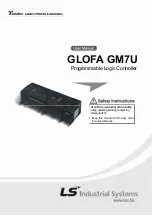MC68332
TIME PROCESSOR UNIT
USER’S MANUAL
7-7
7.4.4 Pulse-Width Modulation (PWM)
The TPU can generate a pulse-width modulation waveform with any duty cycle from
zero to 100% (within the resolution and latency capability of the TPU). To define the
PWM, the CPU provides one parameter that indicates the period and another param-
eter that indicates the high time. Updates to one or both of these parameters can direct
the waveform change to take effect immediately, or coherently beginning at the next
low-to-high transition of the pin.
7.4.5 Synchronized Pulse-Width Modulation (SPWM)
The TPU generates a PWM waveform in which the CPU can change the period and/
or high time at any time. When synchronized to a time function on a second channel,
the synchronized PWM low-to-high transitions have a time relationship to transitions
on the second channel.
7.4.6 Period Measurement with Additional Transition Detect (PMA)
This function and the following function are used primarily in toothed-wheel speed-
sensing applications, such as monitoring rotational speed of an engine. The period
measurement with additional transition detect function allows for a special-purpose
23-bit period measurement. It can detect the occurrence of an additional transition
(caused by an extra tooth on the sensed wheel) indicated by a period measurement
that is less than a programmable ratio of the previous period measurement.
Once detected, this condition can be counted and compared to a programmable num-
ber of additional transitions detected before TCR2 is reset to $FFFF. Alternatively, a
byte at an address specified by a channel parameter can be read and used as a flag.
A nonzero value of the flag indicates that TCR2 is to be reset to $FFFF once the next
additional transition is detected
7.4.7 Period Measurement with Missing Transition Detect (PMM)
Period measurement with missing transition detect allows a special-purpose 23-bit pe-
riod measurement. It detects the occurrence of a missing transition (caused by a miss-
ing tooth on the sensed wheel), indicated by a period measurement that is greater than
a programmable ratio of the previous period measurement. Once detected, this con-
dition can be counted and compared to a programmable number of additional transi-
tions detected before TCR2 is reset to $FFFF. In addition, one byte at an address
specified by a channel parameter can be read and used as a flag. A nonzero value of
the flag indicates that TCR2 is to be reset to $FFFF once the next missing transition
is detected.
7.4.8 Position-Synchronized Pulse Generator (PSP)
Any channel of the TPU can generate an output transition or pulse, which is a projec-
tion in time based on a reference period previously calculated on another channel.
Both TCRs are used in this algorithm: TCR1 is internally clocked, and TCR2 is clocked
by a position indicator in the user's device. An example of a TCR2 clock source is a
sensor that detects special teeth on the flywheel of an automobile using PMA or PMM.
The teeth are placed at known degrees of engine rotation; hence, TCR2 is a coarse
representation of engine degrees, i.e., each count represents some number of de-
grees.
F
re
e
sc
a
le
S
e
m
ic
o
n
d
u
c
to
r,
I
Freescale Semiconductor, Inc.
For More Information On This Product,
Go to: www.freescale.com
n
c
.
..

















